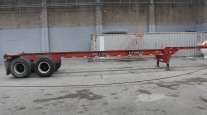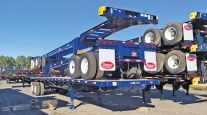Fleet Chassis Citations Continue Despite New FMCSA Regulation
This story appears in the April 25 print edition of Transport Topics.
As a new federal chassis rule is taking effect this spring, frequent errors are hurting intermodal fleets’ safety records and saddling them with violations that were supposed to be charged against chassis providers, according to industry officials.
Jeff Lang, president of Eagle Systems Inc., East Wenatchee, Wash., and Curtis Whalen, executive director of the Intermodal Motor Carriers Conference, told Transport Topics the troubles include mistakes and improper guidance by inspectors as well as gaps in dispute-resolution systems at the Federal Motor Carrier Safety Administration.
“We are getting charged with trailing-unit violations, such as chafed air [brake] lines and brakes out of adjustment, that should be the responsibility of the intermodal equipment provider,” Lang said, noting that the problem was industrywide.
Whalen explained that those violations can’t be detected without doing an inspection under the chassis, and that chassis-storage methods often made such inspections impossible.
Lang said brakes should be properly adjusted before the motor carriers get the equipment and that the rules don’t allow drivers to go under the chassis.
FMCSA spokesman Duane DeBruyne responded by saying that the inspection procedures mandated by the agency and its dispute resolution mechanisms both are functioning properly.
DeBruyne said inspectors are instructed to ask whether drivers had enough space to do a pre-trip inspection and whether they did that inspection. He also said defects that drivers could not see or hear during the inspection are supposed to be assigned to the equipment provider.
“This wouldn’t be quite the problem that it is if it wasn’t for CSA,” Whalen said, referring to the FMCSA’s Compliance, Safety, Accountability program, which measures carrier violations on categories that include maintenance. “All of this starts to screw up your CSA number.”
Difficulties with violations mark the latest turn in drayage fleets’ multi-decade campaign to have chassis providers — primarily ocean carriers and lessors — take responsibility for the condition of their chassis. Efforts began in 1999 to shift responsibility to chassis providers, culminating with legislation in 2005. It has taken the intervening six years for FMCSA to write and phase-in the regulations.
“There are hiccups all across the board,” as the rules take effect, said Stephen Keppler, executive director of the Commercial Vehicle Safety Alliance, whose members perform truck safety inspections.
“It is not the roadside enforcement officer’s job to play judge,” Keppler said. “His or her job is to identify violations. The back-office databases need to assign those violations to the proper party, whether it is the [intermodal equipment provider] or the motor carrier.”
A second problem, said Lang, who also is chairman of the IMCC, a division of American Trucking Associations, is not having FMCSA’s data “scrubbed” to remove errors and violations improperly assigned to carriers.
“The fact that you can’t fix the mistakes on violations [in FMCSA’s database] is the sharp stick in the eye,” Whalen added.
FMCSA’s DeBruyne responded: “Disputes of any safety data can be submitted to the [FMCSA’s] DataQs system, which is an electronic means for filing concerns. Information about the data concern is automatically forwarded to the appropriate [state] office for resolution.”
Whalen also charged that FMCSA conducted a webinar where agency officials said, “If there is doubt about who should be cited for a violation, then it should be the motor carrier.”
Asked about that allegation, DeBruyne reiterated that defects drivers can’t see or hear will be charged to the equipment provider.
There are no statistics to measure how often mistakes are occurring, said Whalen, who urged more training for inspectors.
“I wouldn’t say [training] is a concern,” CVSA’s Keppler said. “We have had training webinars over the past couple of months. We have put together training bulletins. When you have the entire country moving in this direction, it is going to take some time to make this information available to everybody.”
“It is a pretty major shift for everyone,” Keppler added. “The important thing to note is that everyone is working toward the common goal — to ensure that the equipment is as safe as it can be, ensure that people know what the expectations and roles are and respond when things are discovered so that we are taking the appropriate action to fix it.”




